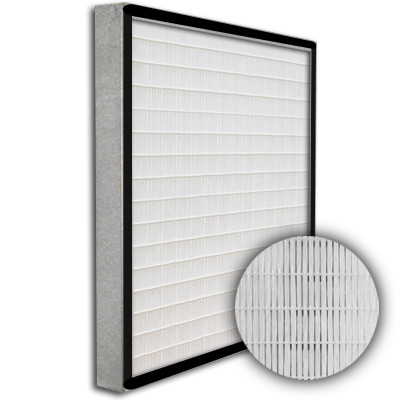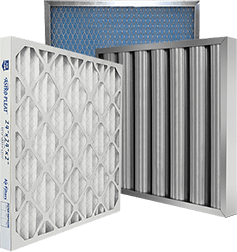
What is a HEPA filter?
HEPA is an acronym that stands for High Efficiency Particulate Air. The National Air Filtration Association (NAFA) defines HEPA filters as a filter having a minimum efficiency of 99.97% on 0.3 micrometer particles. HEPA filter’s paper media is composed of micro-glass fibers, synthetic fibers, or expanded film like polytetrafluoroethylene (PTFE) that are pleated back and forth like an accordion to form a tight and compact filter element with a large surface area. This tight pleating is required because the paper has a high resistance to airflow and the media velocity is usually in the range of 6 fpm (.03 m/s). HEPA filters work by forcing air through the media’s fine mesh or “net” that traps dangerous particles such as pm2.5, dust, pollen, pet dander, viruses, bacteria, and micro-organisms. The 0.3-micron standard is used in efficiency ratings, because it estimates the most difficult particles size for a filter to capture (MPPS). They are designed to target very small particles and are not intended to work like a typical membrane filter, where particles larger than a given pore size of a filter are captured. However, HEPA filters are often more efficient in blocking and filtering particles that are smaller than 0.3 microns and larger than 0.3 microns. HEPA filters are a type of mechanical filter, which captures particles in four different filtration mechanisms based on particle size and velocity, which include inertial impaction, interception, diffusion, and straining.
Mechanical Filtration Mechanisms
- Intertial Impaction/Impingement
- Interception
- Diffusion
- Straining/Sieving
Inertial Impaction is the mechanism by which large high-density particles are captured. As air flows through a filter, it bends and sometimes changes direction several times to pass around the filter media fibers. Large particles resist change in direction and attempt to continue in their original direction because of their inertia, this causes them to collide with and attach to the fibers.
Interception is the mechanism by which mid-size particles that are not large enough to have inertia but not small enough to diffuse follow the air stream as it curves and bends through the fiber spaces. The particulates are then trapped when they collide with the fibers.
Diffusion is the mechanism by which the smallest particles are captured at lower air velocities. As polluted air passes through the filter media the smallest particles move erratically or an in zig-zag pattern from higher concentrated areas, this is known as Brownian Motion. This slows down the particle’s path and increases the probability of the particle being captured by the media and become trapped. Diffusion is most effective with fine fibers and extremely low air velocities.
Straining is the most common filter mechanism and occurs when the particle is too large to fit between the filter fiber spaces.
Performance and Testing
The HEPA performance testing does not measure efficiency, it measures penetration. i.e., the fraction of a challenge aerosol which passes through the filter. The efficiency is calculated by subtracting the penetration (percent) from 100%. The original maximum penetration was 0.03% so that efficiency was 99.97% (100 minus 0.03).
Air Filters Incorporated uses the EN 1822:2009 standard for testing our HEPA and ULPA filters. EN 1822:2009 is the standard used for HEPA and ULPA filter testing in Europe. The test defines characteristics for:
- Classification
- Performance Testing
- Leak finding
- Collection efficiency determination
| Standard | Filtration Rate | Filter Type |
| ISO/European (ISO 29463/EN 1822) | 85%-99.95% | EPA (Efficient Particulate Air) |
| ISO/European (ISO 29463/EN 1822) | 99.95%-99.999% | HEPA (High-Efficiency Particulate Air) |
| ISO/European (ISO 29463/EN 1822) | >99.999% | ULPA (Ultra Low Penetration Air) |
Applications and Industries that Use HEPA Filters
HEPA filters are used in heavily regulated environments and industries that have strict quality requirements. Some of these include pharmaceutical, cleanrooms, semiconductor manufacturing, food processing, laboratories, hospitals and more.
FAQ
Are HEPA filters washable?
- In short, no. When a HEPA filter is exposed to water, the strength of the filter media is weakened.
What is the filter life of HEPA's?
- The longevity of HEPA filters depends on the application and operating conditions. But a good rule of thumb is that, at a minimum, the filter should be replaced when the pressure drop reaches two times the initial pressure drop.
What is the shelf life of a HEPA filter?
- According to the US Department of Energy, "it is recommended that HEPA-filter life under dry conditions be set at 10 years."
References:
https://www.standards.doe.gov/standards-documents/1100/1169-bhdbk-2003-appc/@@images/file
There are no products matching the selection.
Customize Your Air Filter in 4 Easy Steps
APPLICATION

EFFICIENCY

DIMENSIONS

DELIVERY


Air Filters, Inc. is committed to providing a "one-stop shop" for all of your air filtration requirements. As an air filter manufacturer, we are uniquely positioned to custom make any and all types of air filters.
build your custom filter now
Have a Question?
Send us a message below or call us at 1.800.667.8563
Resources
-
Track My Order
Ordered your filters and need to know where they are?
-
Careers
Want to work for Air Filters Inc.? We are hiring!
-
Glossary
Browse a full list of industry terms to better choose your filters.
-
Download Catalog
Receive our full product catalog via email.
-
Affiliates
View all of our Company Brands.
-
Video Library
Need to know how to install your filters? Watch helpful videos from AFI.






